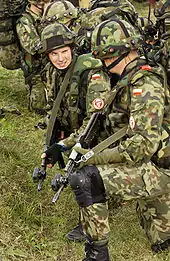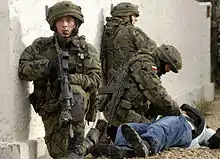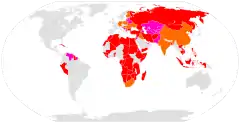FB Beryl
The karabinek szturmowy wzór 1996 Beryl (English: assault rifle model 1996 beryllium) is a Polish 5.56mm assault rifle, designed and produced by the Łucznik Arms Factory in the city of Radom. The rifle is to replace the 7.62×39mm AKM and 5.45×39mm FB Tantal used in the Polish Armed Forces.
| Karabinek szturmowy wz. 1996 Beryl | |
|---|---|
.jpg.webp) The rifle cal. 5.56 wz. 96 Beryl. | |
| Type | Assault rifle |
| Place of origin | Poland |
| Service history | |
| In service | 1997–present |
| Used by | See Users |
| Wars |
|
| Production history | |
| Designer | FB "Łucznik" Radom |
| Designed | 1995–1996 |
| Manufacturer | FB "Łucznik" Radom, Defence Industries Corporation of Nigeria |
| Produced | 1997–present |
| Variants |
|
| Specifications | |
| Mass | 3.35 kg (7.39 lb) (without magazine) |
| Length |
|
| Barrel length | 457 mm (18.0 in) |
| Cartridge |
|
| Action | Gas-operated, rotating bolt |
| Rate of fire | 700 rounds/min |
| Muzzle velocity | 920 m/s (3,018 ft/s) |
| Effective firing range | 100–1,000 m sight adjustments |
| Maximum firing range | 600 m |
| Feed system |
|
| Sights | Rear sight notch on a sliding tangent, front post |
Development

Development work on a new service rifle (both a standard and carbine variant) adapted to use the intermediate 5.56×45mm NATO cartridge had been undertaken in 1995, however a functioning 5.56 mm rifle and carbine variant had already been available in Radom since 1991, known as the wz. 1991 (a rechambered wz. 1988 Tantal rifle). The new weapon's specifications were approved in February 1995 and in December the same year, a prototype production batch consisting of 11 Beryl rifles was produced. In 1997 the weapon had been successfully evaluated and adopted into service as the 5,56 mm karabinek szturmowy wz. 1996 ("assault carbine pattern 1996").
The Beryl subsequently became the standard Polish rifle. In 2011, there were more than 45,000 in the inventory, accounting for about half of the assault rifles in the Polish Army.[1] On May 25, 2016, FB "Łucznik" Radom announced an order from the Polish Army for 26,000 Beryls and Mini-Beryls, though did not break it down by system.[2]
Apart from Poland, 80 wz. 96A Beryls and 10 wz. 96A Mini Beryls are used by Lithuania (donated in May 2000 by Poland, including 10 rifles with Pallad grenade launcher and 10 rifles with CWL-1 scope with integrated laser rangefinder). Until 2002/2003 they were equipment of a special forces unit SOJ Aitvaras, operating in Afghanistan.[3]
Design details

The Beryl's design layout and system of operation are similar to those of the Tantal rifle, and the principal differences, resulting primarily from using a different cartridge, include the following components: the barrel, receiver housing, buttstock, foregrip, muzzle device, sight system and magazine. With an adapter, it can use M16 NATO standard magazine.
The 457 mm-long barrel, has six right-hand grooves and a 228 mm (1:9 in) twist rate. The barrel's external profile (from the breech to the front sight base) is identical to the Tantal's barrel, but the length from the foresight base has a visible tapered contour with a decreasing diameter towards the muzzle end, used to mount a flash suppressor.
The flash hider can be used to mount and launch rifle grenades. The flash hider has a slight taper at the front that supports a bayonet and a little further to the rear – six side ports arranged in pairs. These ports are placed asymmetrically around the circumference of the flash hider and stabilize the weapon during continuous fire. Internally the flash suppressor features threading at the muzzle used to screw-in a blank firing attachment. Located mid-length on the flash hider is a cut-out with a ring retainer spring that secures a rifle grenade to the barrel.
The receiver housing contains several modifications over the receiver of the wz. 1988 rifle. It uses a reinforced rear stock trunnion, adapted for the new shoulder stock and a top-mounted Picatinny rail for mounting optical sights.
The side-folding tubular metal stock is coated with a thermal polymer shrink film. It has a metal shoulder stop covered with a rubber recoil pad. More recent models come with a collapsible stock (see picture of wz. 2004 model on right side of page).
The standard lower handguard features an angled rib pattern designed to enhance gripping by the support hand. The rear of the handguard features two molded notches that enable the 40 mm wz. 1974 grenade launcher to be mounted under the barrel (early versions of the wz. 1996 lacked these notches, fitted instead with handguards with lateral grooves). Some Beryl handguards are equipped with short Picatinny rails and an integral vertical foregrip.
The Beryl's sighting system is very similar to the setup used on the Tantal, it does however differ with the addition of twin cuts made into the sides of rear sight base that are used to fasten a bracket for mounting the following optical sights: the passive PCS-6 night sight, a CK-3 reflex optical collimator (red dot sight), LKA-4 telescopic sight and CWL-1 scope with integrated laser rangefinder. However, the most used additional sight for Beryl is EOTech 552 holographic weapon sight and PCS-5M passive night sight. PCS-6 and CWL-1 are introduced in small number.
The weapon's unique magazine is molded from plastic and is not interchangeable with magazines from the kbk wz. 1988 Tantal.
The Beryl has a long, trapezoid-shaped selector switch, similar to those found on the AK-47 or almost all of the AK series.
The Beryl fires 5.56×45mm ammunition with a steel-core standard round, a tracer cartridge and a training slug, which are produced by Zakłady Metalowe Mesko in the town of Skarżysko-Kamienna.
Standard equipment shipped with the rifle includes: three spare magazines, four 15-round stripper clips, a stripper clip guide, bayonet, cleaning kit, lubricant bottle, cleaning rod (two-piece, stored in the cleaning kit pouch), sling, a magazine pouch and bipod. The rifle can also be fitted with a mounting system for optical sights and a blank-firing adaptor.
The Beryl was used to create a carbine variant known as the Mini-Beryl.
Variants

- kbs wz. 1996A Beryl (1996) (photograph): standard version of Beryl, the most produced version for Polish Forces, some examples were equipped with POPC I rail, where Polish sights (CWL-1, CK-3, LKA-4, PCS-6) could be mounted, but most mounted rail is POPC III. In Iraq, some Beryls were modified and received wooden fore grip from PM md. 63 (photograph)
- kbs wz. 1996B Beryl (2004) (photograph): same as standard version, but with fixed fore grip and rails on it. Also, "B" version get new rail, POPC II (short) and POPC III (long) which subtended the Picatinny standard (however, some "B" Beryls get POPC I rail).
- kbs wz. 1996C Beryl (2009) (photograph): version with new buttstock (which is fixed and telescopic), new rails (POPC IV), new handguard, magazines and new fore grip.
- kbs wz. 1996D Beryl (2013–2014) (photograph): version with the same buttstock as in "C", but foldable, STANAG magazines, rails adherent to cover, foldable sight. Polish Armed Forces refused buying this variant, however, there are orders on "C" variant.
- Beryl M545 (2011): proposed 5.45×39mm export variant[4]
- Beryl M762 (2013): "C" export variant chambered to fire 7.62×39mm ammunition. Bought by Nigeria.
Users
 Afghanistan: an unspecified number was donated by Poland.[5]
Afghanistan: an unspecified number was donated by Poland.[5] Lithuania: around 80 units of wz. 1996A (10 with wz. 74 Pallad and 10 with CWL-1) in use by special forces and by recon units.[6]
Lithuania: around 80 units of wz. 1996A (10 with wz. 74 Pallad and 10 with CWL-1) in use by special forces and by recon units.[6] Nigeria: 1,000 units of the Beryl M762 (wz. 96C version in 7.62×39mm cartridge) were delivered to the Nigerian Armed Forces in 2014, 500 in 2015.[7] Fabryka Broni Łucznik is expecting a delivery contract exceeding 6000 units in the following years, should the Nigerian Army decide to fully adopt the weapon.[8] At this moment (July 2017) Nigerian Army has 2,000 units of this weapon.[9] In March 2018 Defence Industries Corporation of Nigeria (DICON) signed a letter of intent to manufacture the rifles in Nigeria.[10]
Nigeria: 1,000 units of the Beryl M762 (wz. 96C version in 7.62×39mm cartridge) were delivered to the Nigerian Armed Forces in 2014, 500 in 2015.[7] Fabryka Broni Łucznik is expecting a delivery contract exceeding 6000 units in the following years, should the Nigerian Army decide to fully adopt the weapon.[8] At this moment (July 2017) Nigerian Army has 2,000 units of this weapon.[9] In March 2018 Defence Industries Corporation of Nigeria (DICON) signed a letter of intent to manufacture the rifles in Nigeria.[10] Poland: around 80,500 units (+74,147 wz. 96C Beryl on order[11]), includes all versions (wz. 1996A, wz. 1996B, wz. 1996C) and Mini-Beryl[12][13]
Poland: around 80,500 units (+74,147 wz. 96C Beryl on order[11]), includes all versions (wz. 1996A, wz. 1996B, wz. 1996C) and Mini-Beryl[12][13] Turkey: wz.2004 in lmited use by anti terror units of General Directorate of Security (Turkey).[14]
Turkey: wz.2004 in lmited use by anti terror units of General Directorate of Security (Turkey).[14]
See also
References
- Michał Sitarski, MSBS-5,56 in: Nowa Technika Wojskowa 7/2011, p.32 (in Polish)
- FB "Łuchnik" Radom, Facebook page.
- Remigiusz Wilk (REMOV), G36K/KV dla Litwy in: Raport WTO Nr.12/2007, p. 62 (in Polish)
- Wilk, Remigiusz: Broń strzelecka w Kielcach, "RAPORT Wojsko Technika Obronność" Nr. 11/2013, p. 37 (in Polish)
- Beckhusen, Robert (29 March 2018). "One of the Best AK-47 Variants Is Polish". War is Boring.
- "G36 dla Litwy - Altair Agencja Lotnicza". altair.com.pl.
- http://www.altair.com.pl/news/view?news_id=17144
- http://www.altair.com.pl/news/view?news_id=15145
- "Beryle M762 dla Nigerii". milmag.pl (in Polish).
- Martin, Guy (29 March 2018). "Nigeria to manufacture Beryl assault rifles". www.defenceweb.co.za. Retrieved 29 March 2018.
- http://www.altair.com.pl/news/view?news_id=19508
- "7,9 tys. Beryli dla WP - Altair Agencja Lotnicza". altair.com.pl.
- Sabak, Juliusz (January 18, 2017). "Wojsko kupi 57 tys. Beryli. Większość trafi do OT" [The army will purchase 57 thousand Beryl rifles. Most will go to OT] (in Polish). Archived from the original on September 1, 2017. Retrieved July 7, 2017.
- "Question? - Which sort of rifle is that and what are its add-ons?". MilitaryImages.Net. Retrieved 2021-01-28.
External links
| Wikimedia Commons has media related to Kbs wz. 1996 Beryl. |


